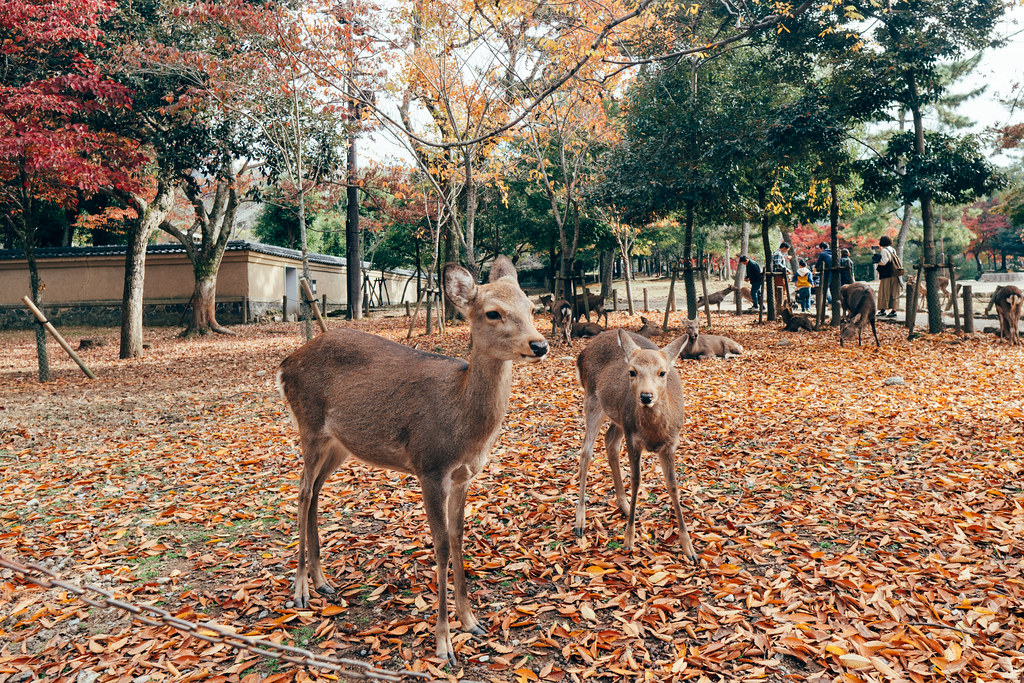On a Sunday of our 4 days in Osaka, we took a train to visit Japan’s oldest capital. During the Nara Period from year 710 to 794, the first capital was established in Nara and later moved to Kyoto. In this era, Buddhism was a strong influence and the temples in Nara dated back to this period.
Transportation
It is super convenient to visit Nara from Osaka or Kyoto. We took Kintetsu (近鐵) from Osaka Namba station, and the ride was under an hour with a scenic view along the way. From the Nara station, it was about 10-15 walk to the entrance of the park where we saw the deer.
Highlights
The deer
Based on the history of Kasuga Grand Shrine (春日大社), a white deer arrived in Nara to protect Nara and the country back in the Nara Period. The belief carried on, and people deem the deer as heavenly animals sent by the spiritual God. All the deer in Nara are wild, and the vendors sold “deer snack” (senbei made out of rice bran and wheat flour) at a fixed price. The deer were eager to eat our senbei in the morning but they eventually got tired of the snacks in the late afternoon, probably due to the volume of tourists.


Lunch at Shizuka (志津香)
This 50-year old family restaurant usually has a line, and we joined the queue about 20 minutes before its opening. Most of the customers seemed to be Asian tourists, including us who came from a blog post. The menu offers variants of Kamameshi (釜めし), rice cooked in an iron pot. The seasonal menu had oysters, and I got the classic rice set with Nara seven specialty including shrimp and unagi. I loved the meal a lot, with the rice warm in the pot and slightly burned at the bottom.

Temples and shrines
5 Buddhist temples and one Shinto shrine are listed in the UNESCO World Heritage Site Historic Monuments of Ancient. We walked around the most popular temple Todaiji (東大寺), and the crowd disappeared when we walked beyond the main temple building. In addition, the autumn foliage added so many colors to the surroundings.


Hiking Mount Wakakusa (若草山)
After lunch, we went on a hike to Mount Wakakusa. The trailhead was about a 15-minute walk from Todaiji, and the crowd shrank suddenly after the end of the shops. The trail was quite easy, and it was mostly shaded. The trees were beautiful of various shades of green, yellow, and red. On top of the mountain, we enjoyed a view of the city with a few deer. If you are planning to visit Nara in the winter, there is a mountain burning festival on the 4th Saturday of January, a tradition since 1760.


Souvenir shopping streets
There are a few streets between the Nara Park and the Nara Kintetsu station, and my favorite was the Mochiidono shopping street. We stopped by the famous yomogi mochi shop Nakatanidou (中谷堂) to watch the high speed pounding performance and had a fresh mochi that just went on sale.


Wrapup
While the deer might be the top reason for the visit, so much culture and history were preserved in the temples and shrines dating back to more than 1200 years ago. I would certainly come back to Nara next time in Osaka or Kyoto, perhaps on a weekday to avoid the crowd.
Last but not least, I’d like to share our lists of places and itinerary for our visits to Osaka, Nara, and Kobe.

1 thought on “Day trip to Nara, Japan”